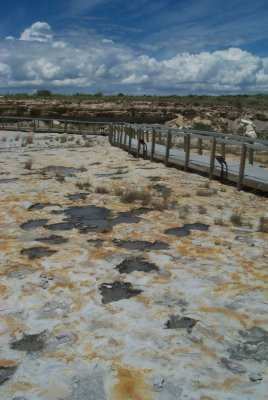Dinosaur Tracks along the Trails West
Clayton Lake, New Mexico

Recent rains define dinosaur tracks at spillway of Clayton Lake, New Mexico


Recent rains define dinosaur tracks at spillway of Clayton Lake, New Mexico

During their 160-million-year-long reign, dinosaurs made trillions of footprints, but only a small percentage of these footprints found their way into the fossil record. In the rolling grasslands of the extreme northeastern corner of New Mexico, near the Santa Fe Trail, an earthen dam was constructed in the 1950s across Seneca Creek that resulted in the formation of Clayton Lake. The excavation of the spillway, and a flood in 1982 that swept away a layer of silt from the spillway, uncovered an unexpected bonanza of dinosaur tracks, preserved in the Early Cretaceous sandstones of the upper Dakota Group, dated at about 100 million years old. Today, the tracksite, with over five hundred dinosaur footprints, is one of the best-preserved and most extensive dinosaur tracksites in the United States. A sheltered gazebo and boardwalk were placed along the trackway, with extensive information about the dinosaurs who lived here so long ago. Overall, at least eight different kinds of dinosaurs left their marks on this ancient mudflat.
Adrian Hunt, PhD., curator of the Mesalands Dinosaur Museum, and Professor of Paleontology at Mesa Technical College, Tucumcari, New Mexico, is seen standing near fossilized mud cracks at Clayton Lake. These are called "dessication cracks." These can be seen forming today on mud that is drying out; the mud cracks, in a polygonal pattern, as it dries. This demonstrates features that can be used to reconstruct the environment in which the tracks were made. The picture that emerges from these clues is of a sandy or muddy flat, partly dried out, but still retaining pools and inlets of shallow water. Over this sand flat, sinking a bit in the not-fully-dry muddy sand, herds of dinosaurs once walked.
This photo to the right shows parts of two dinosaur trackways on the spillway at Clayton Lake. On the left is an ornithopod trackway, with its distinctive broad, three-toed hindfoot track shape. On the right are smaller rather unusual tracks, looking rather like kites, but clearly showing three toes at the front.
Primitive ornithopod dinosaurs, the iguanodonts, made most of the tracks at Clayton Lake. These are the three-toed footprints of animals that either walked bipedally, or occasionally leaned forward to walk on all fours. They are easily recognized because of their square heels and lack of claw marks. In contrast, a few footprints at Clayton Lake are those of theropods, meat-eating dinosaurs. They are easily recognized by their pointed heels and sharp, clawed toes.
The remarkable dinosaur tracksite at Clayton Lake State Park truly makes Clayton the "dinosaur track capital of New Mexico." For more information, contact Clayton Lake State Park at Rural Route, Box 20, Seneca, NM 88437 or by telephone at 505/374-8808.
More detailed information about Dinosaur Tracks at Clayton Lake, taken from Dr. Hunt's research.
Lockley, M. and Hunt, A. P. 1995. Dinosaur Tracks and Other Fossil Footprints of the Western United States. Columbia University Press, New York.
Send comments, suggestions or inquiries:
Overland Trail
Created and maintained by Elizabeth Larson
Copyright © 1996-2001